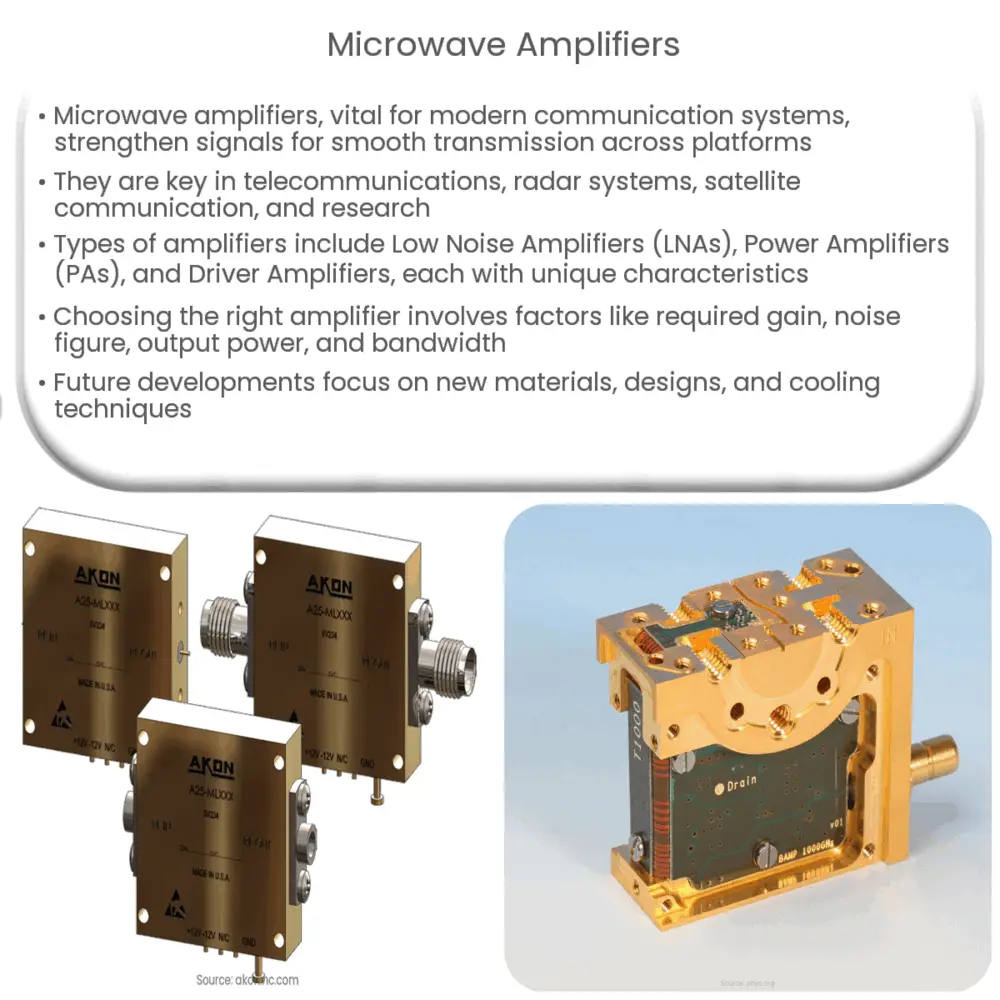Microwave amplifiers boost signal strength in communication systems, enabling reliable transmissions in telecom, radar, and satellite applications.

Microwave Amplifiers: The Backbone of Modern Communication Systems
In the fast-paced world of modern communication systems, microwave amplifiers play an integral role in ensuring the smooth transmission of signals across various platforms. These devices are designed to amplify microwave frequency signals, boosting their strength and preserving signal quality over long distances. This article explores the basic principles of microwave amplifiers, their applications, and the different types available in the market.
Understanding Microwave Amplifiers
A microwave amplifier is an electronic device that increases the power of a microwave signal without significantly distorting its waveform. This is achieved by taking a low-level input signal and converting it into a higher-level output signal. The process of amplification relies on active devices, such as transistors or vacuum tubes, which are capable of providing the necessary gain to boost the signal’s strength.
There are several factors that contribute to the performance of a microwave amplifier. Some of these factors include gain, noise figure, output power, and bandwidth. Gain refers to the amount of amplification the device can provide, while the noise figure represents the amount of noise added by the amplifier to the input signal. Output power indicates the maximum power that the amplifier can deliver, and bandwidth denotes the range of frequencies the amplifier can process effectively.
Applications of Microwave Amplifiers
Microwave amplifiers find a wide range of applications in various industries, including telecommunications, radar systems, satellite communication, and research. Some specific applications include:
- Telecommunications: In cellular networks and other wireless communication systems, microwave amplifiers are essential for signal transmission between base stations and mobile devices. They ensure that signals maintain adequate power levels to cover large areas without significant loss of quality.
- Radar Systems: Radar systems rely on microwave amplifiers to transmit and receive signals. The amplifiers boost the power of transmitted signals, enabling the radar system to detect objects at greater distances and with higher accuracy.
- Satellite Communication: Microwave amplifiers play a crucial role in satellite communication systems, where they amplify the signals transmitted between Earth and satellites. This ensures reliable communication with minimal signal degradation, even across vast distances in space.
- Research: In scientific research, microwave amplifiers are used in various applications, such as particle accelerators and radio astronomy. They help to maintain signal integrity and enhance the sensitivity of measurement instruments.
Types of Microwave Amplifiers
There are several types of microwave amplifiers, each with its own unique characteristics and advantages. Some of the most common types include:
- Low Noise Amplifiers (LNAs): LNAs are designed to minimize the noise figure, making them ideal for applications requiring high sensitivity and minimal signal distortion, such as satellite communication and radio astronomy.
- Power Amplifiers (PAs): PAs focus on providing high output power and are commonly used in applications like radar systems and cellular base stations, where the transmission of strong signals over long distances is crucial.
- Driver Amplifiers: Driver amplifiers are used to drive the input stage of a power amplifier, effectively increasing the overall gain of the system. They are commonly found in telecommunications and radar systems.
In conclusion, microwave amplifiers play a critical role in modern communication systems and have a wide range of applications. Understanding their basic principles, applications, and types is essential for selecting the
right device for specific needs.
Selecting the Right Microwave Amplifier
Choosing the appropriate microwave amplifier for a specific application involves considering several factors, such as required gain, noise figure, output power, and bandwidth. Here are some guidelines to help in the selection process:
- Identify the Application: Understand the specific requirements of the application, such as the need for high sensitivity, high output power, or a combination of both. This will help you determine which type of amplifier is best suited for the job.
- Define Performance Parameters: Determine the necessary performance parameters for your application, such as gain, noise figure, output power, and bandwidth. These parameters will guide your search for a suitable amplifier.
- Consider System Constraints: Keep in mind any system constraints, such as size, weight, power consumption, and cost, which may affect the choice of an amplifier. Select an amplifier that meets the performance requirements without exceeding these constraints.
- Consult Manufacturer Specifications: Review the datasheets and specifications provided by amplifier manufacturers to compare the performance and features of various models. This will help you find an amplifier that meets your specific needs.
Future Developments in Microwave Amplifiers
As communication technologies continue to evolve, the demand for high-performance microwave amplifiers grows. Researchers and engineers are constantly working on developing new materials, designs, and techniques to improve the performance of these devices. Some promising areas of research and development include:
- Gallium Nitride (GaN) Technology: GaN-based amplifiers offer advantages such as high power density, high efficiency, and wide bandwidth capabilities. They are increasingly being used in radar, satellite communication, and 5G wireless systems.
- Monolithic Microwave Integrated Circuits (MMICs): MMICs are compact, integrated circuits that can be used to build complex microwave systems, including amplifiers. The development of advanced MMIC technology enables the miniaturization of microwave amplifiers, leading to smaller and lighter devices with improved performance.
- Advanced Cooling Techniques: As microwave amplifiers become more powerful, managing heat dissipation becomes a critical challenge. Researchers are exploring new cooling techniques, such as microchannel cooling and phase-change materials, to ensure the longevity and reliability of high-power amplifiers.
In summary, microwave amplifiers are indispensable components in modern communication systems, with applications in telecommunications, radar systems, satellite communication, and research. Understanding the principles, applications, and types of microwave amplifiers, as well as the factors to consider when selecting the right device, is essential for optimizing system performance. As technology advances, the development of new materials, designs, and techniques will continue to enhance the capabilities of these critical devices.



